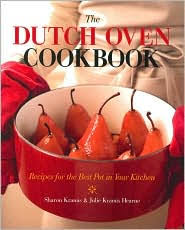Cast iron cookware has been around for hundreds of years. Centuries ago, cast iron kettles and skillets were used over open fires in Europe. They were one of the very few treasured items that settlers brought with them to the New World.
Cast iron pans are formed through the process of sand-casting. Molten iron is poured into a sand-clay mold of the desired shape,. After it cools, the mold is removed and the pan's surface is smoothed by a stone-washing process. Although pioneer cast iron companies, Griswold Manufacturing and Wagner Manufacturing, are no longer in business, you can occasionally discover them at secondhand stores. They are a great find. Well-seasoned and well-used, they are my favorite!
Often, cooks who are unfamiliar with cast iron are pleasantly surprised to find that well-seasoned cast iron has a perfect nonstick surface. Teflon-coated and stainless steel pans tend to cause food to "sweat" which stews and toughens meat instead of browning it, and prevents a crisp crust from forming. Food cooked in cast iron doesn't sweat. Cast iron pans heat quickly and evenly and maintain their heat. They provide an even exchange of heat with the food, thus allowing meats to brown and caramelize, staying tender. The high heat of the pan forms golden crusts on baked goods and acts just like a wood-fired oven for pizzas and breads.
Nowadays most new cast iron pans come preseasoned which means you can use them right out of the box. (For cast iron, the point of "seasoning" is to bake the fat into the pan's porous surface to create a smooth, permanent nonstick coating and to prevent rust.) However, it's a good idea to re-season your pan every so often. Show your cast iron pan some good use and love, and it will thank you with increasingly complex, mature, and unforgettable flavors!
Saturday, December 20, 2008
Sunday, December 7, 2008
Cornbread Pudding
The following savory pudding recipe was inspired by Seattle chef and restaurant owner, Tom Douglas. My Mom and I love to pair it with barbecued ribs or any slow-cooked meat or salmon. The cornbread stays moist in on the inside, crispy and golden on the outside. Delicious!
Cornbread Pudding
Makes 6 Servings
Cornbread Pudding
Makes 6 Servings
4 1/2 Cups cubed Moist Cornbread or other cornbread (to save time, you can substitute cornbread made from a mix. Just be sure to let the cornbread cool completely before cutting it into cubes.)
1 Tablespoon unsalted butter
1 Cup thinly sliced yellow onions (about 1/2 large onion)
3/4 cup grated dry Jack cheese, cheddar or Cougar Gold cheddar
2 teaspoons chopped fresh flat-leaf parsley 1/2 teaspoon chopped fresh rosemary 1/2 teaspoon chopped fresh thyme leaves 2 cups heavy cream (for a more custard like version of the pudding, increase heavy cream to 3 cups, and use 4 eggs)
3 large eggs 1 teaspoon kosher salt 1/2 teaspoon freshly ground black pepper
- Position a rack in the center of the oven and preheat to 350 degrees F.
- Put the cubed cornbread in a buttered 1o" or 12" cast iron skillet. Set aside. Heat butter in another skillet over low heat, add the onions and cook very slowly, stirring occasionally, until soft and golden brown, at least 20 minutes. Remove from the heat. Scatter the onions, cheese parsley, rosemary, and thyme over the cornbread cubes. Whisk the heavy cream and eggs with the salt and pepper in a mixing bowl and pour over the cornbread cubes. Let sit for 10 minutes to allow the cornbread to absorb some of the custard. Bake until set and golden, about 40 minutes. Serve hot.
Labels:
Cast Iron Skillet,
Cornbread Pudding,
Recipes
Subscribe to:
Posts (Atom)






